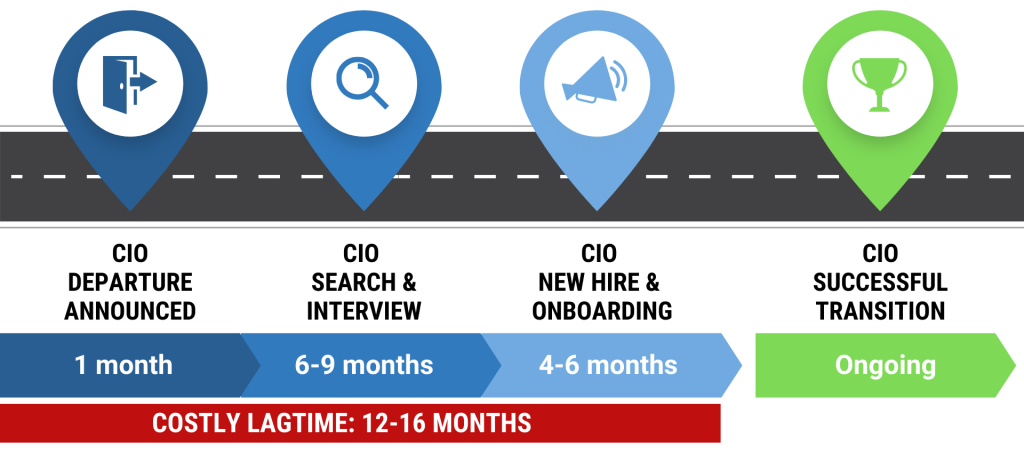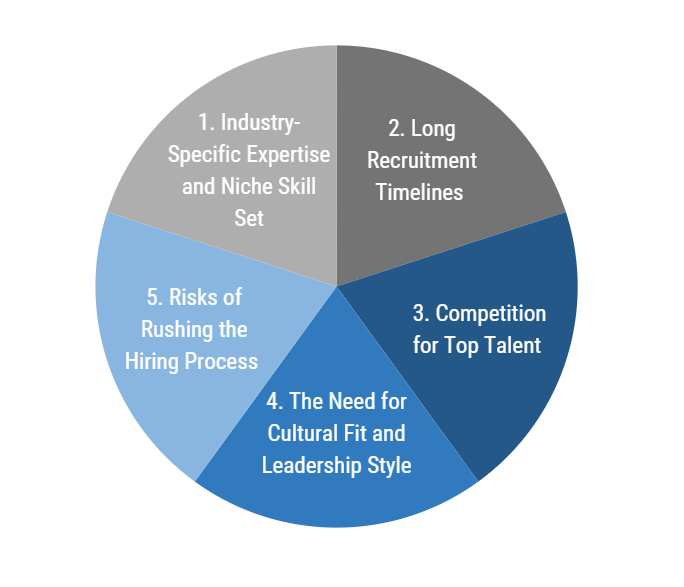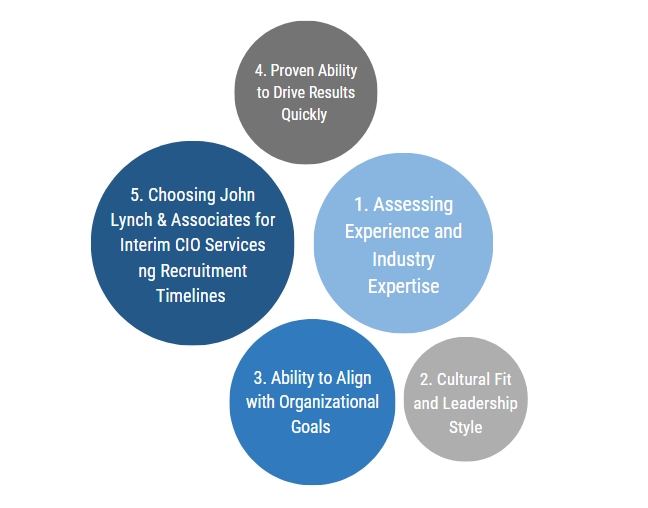
Navigating CIO Vacancies with Interim Leadership
October 17, 2024The role of a Chief Information Officer (CIO) has become essential to managing healthcare organizations’ complex IT needs and strategic goals. A healthcare CIO not only drives the organization’s IT strategy but also ensures the protection of sensitive patient data, oversees compliance with ever-evolving regulations, and steers digital transformation initiatives that enhance patient care and operational efficiency.
When a CIO vacancy occurs, it leaves a significant leadership gap that can disrupt these critical functions, putting the organization at risk of operational slowdowns, cybersecurity threats, and loss of strategic direction.

For many healthcare organizations, finding the right replacement can take months due to the highly specialized skills required for the position. During this time, the absence of leadership can stall ongoing IT projects, delay decision-making, and create vulnerabilities in areas like cybersecurity and compliance. This is where the right interim solution becomes not just an option, but a necessity.
An Interim CIO can quickly step into the role, providing the expertise needed to maintain continuity and address the challenges caused by the vacancy. At John Lynch & Associates, we specialize in offering Interim CIO services that help healthcare organizations navigate these transitions smoothly.
In this article, we’ll explore the challenges of CIO vacancies in healthcare and how an Interim CIO can serve as a strategic solution to bridge the leadership gap.
The Critical Role of a CIO in Healthcare
CIOs play a pivotal role in shaping the IT strategy and operations of a healthcare organization. From managing electronic health records (EHR) systems to ensuring compliance with stringent healthcare regulations like HIPAA, a healthcare CIO is at the center of many critical functions that directly affect both patient care and operational efficiency.
Their responsibilities extend beyond basic IT oversight — they are strategic leaders tasked with driving digital transformation and leveraging technology to improve healthcare delivery.
A CIO is also responsible for managing cybersecurity, a top concern in healthcare given the sensitive nature of patient data. As healthcare organizations continue to be prime targets for cyberattacks, having a strong CIO to oversee security initiatives is essential to minimizing risks.
Additionally, the CIO must stay ahead of the rapidly changing regulatory landscape, ensuring that the organization remains compliant with healthcare laws and guidelines.
Beyond these technical responsibilities, a CIO plays a key role in aligning IT initiatives with broader organizational goals, fostering innovation, and guiding the IT department in ways that enhance overall efficiency and productivity.
Stable leadership in this position ensures that projects are executed smoothly, and that the organization remains competitive in an increasingly digital healthcare landscape.
When a CIO vacancy occurs, the absence of this leadership creates a gap that affects the entire organization. This leadership gap can disrupt long-term strategic initiatives and leave the organization vulnerable to operational inefficiencies and cybersecurity risks.
Without a qualified leader to manage the complexities of healthcare IT, the organization risks falling behind on critical projects and losing its strategic edge.
Consequences of CIO Vacancies in Healthcare
When a healthcare organization experiences a CIO vacancy, the effects can ripple across the entire enterprise. The absence of a dedicated IT leader creates a significant healthcare CIO leadership gap, disrupting not only the IT department but also the organization’s overall strategic direction. Here are some of the most pressing consequences that healthcare organizations face during these vacancies:
Leadership Void and Strategic Drift
A CIO vacancy leaves a strategic void at the highest levels of the organization. The CIO is responsible for aligning IT initiatives with long-term business objectives, and their absence can cause confusion and uncertainty around ongoing projects.
Without a leader to guide IT strategy, key initiatives like digital health transformations or EHR system upgrades often lose momentum. This leadership gap can ultimately result in stagnation, with the organization struggling to keep pace with industry trends or innovation opportunities.
Operational Disruptions and Project Delays
Ongoing IT projects are often the first to suffer when a CIO role is left unfilled. Projects such as system upgrades, new technology implementations, or security overhauls may be delayed, leading to inefficiencies that can negatively affect patient care and day-to-day operations.
Whether it’s upgrading legacy systems or rolling out telehealth platforms, the absence of leadership during a CIO vacancy causes delays that could cost the organization time, money, and opportunities for improvement.

Increased Cybersecurity Risks
In today’s healthcare environment, cybersecurity is one of the most critical responsibilities of a CIO. With sensitive patient data at risk and healthcare systems being frequent targets for cyberattacks, a gap in healthcare CIO leadership increases the likelihood of security breaches.
Without a strong leader to oversee cybersecurity protocols, manage security teams, and respond swiftly to potential threats, the organization is left vulnerable to attacks, data breaches, and non-compliance with healthcare regulations like HIPAA.
Compliance Issues and Regulatory Risks
Healthcare organizations are held to strict regulatory standards, and the CIO plays a crucial role in ensuring compliance. From managing audits to updating systems in line with changing regulations, a CIO vacancy creates gaps in compliance oversight, increasing the risk of non-compliance penalties.
A delay in implementing compliance-related updates or failing to manage security protocols can result in hefty fines and damage to the organization’s reputation.
Loss of Strategic Direction and Innovation
Healthcare IT is a rapidly evolving field, with emerging technologies like AI, telehealth, and data analytics transforming the way care is delivered. A CIO vacancy can stall progress in adopting these innovations, leaving the organization behind its competitors.
Without a visionary leader to identify and implement these opportunities, the organization risks missing out on innovations that could improve patient outcomes and operational efficiency.
The longer the CIO vacancy remains unfilled, the more profound these consequences become. That’s why many healthcare organizations turn to interim CIO services to ensure continuity and mitigate the risks associated with prolonged leadership gaps.
Why Healthcare Organizations Struggle to Fill CIO Vacancies Quickly

Filling a CIO vacancy in healthcare is often a time-consuming and challenging process. Healthcare organizations require a CIO with a unique blend of skills—someone who not only understands information technology but also has deep knowledge of clinical workflows, regulatory requirements, and the business side of healthcare.
This specialized combination of expertise makes the recruiting process particularly difficult. Here are some of the primary reasons why finding the right CIO talent takes so long:
Industry-Specific Expertise and Niche Skill Set
The healthcare industry demands a CIO with experience that goes beyond typical IT management. The role requires a deep understanding of healthcare-specific regulations like HIPAA, along with knowledge of patient care processes, clinical systems, and electronic health records (EHR).
A qualified healthcare CIO must be able to bridge the gap between clinical teams and IT staff, ensuring that technology supports both operational efficiency and patient care. Finding someone with this rare combination of IT, clinical, and business skills is no easy task, leading to lengthy recruitment timelines.

Long Recruitment Timelines
Even in the best circumstances, finding and hiring the right CIO can take months. Healthcare organizations often require candidates with proven leadership experience, a track record of managing large-scale IT projects, and familiarity with the complex regulatory environment. This can significantly narrow the talent pool.
Additionally, the vetting process is often extensive, with organizations seeking to ensure that the candidate is not only qualified but also a cultural fit. During this time, the organization is left with a leadership void, and critical projects are put on hold.
Competition for Top Talent
With the increasing reliance on technology across industries, healthcare organizations are often in competition with other sectors to attract top CIO talent. As digital transformation accelerates in healthcare, so does the demand for leaders who can manage innovation, cybersecurity, and compliance, making experienced CIOs highly sought-after.
This competition makes it even harder for healthcare providers to secure the right candidate quickly.
The Need for Cultural Fit and Leadership Style
Beyond technical expertise, it’s essential that a CIO aligns with the culture and values of the healthcare organization. A CIO must work with multiple stakeholders, from IT teams to clinicians to executive leadership, often in high-pressure environments.
Finding a candidate who not only meets the technical requirements but also meshes well with the organization’s culture and leadership style can be a challenge. Ensuring good cultural fit extends the recruitment process even further.
Risks of Rushing the Hiring Process
Given the high stakes involved, healthcare organizations are often cautious about rushing the recruitment process. A bad hire at the CIO level can have serious repercussions, from misaligned IT strategies to costly delays in critical projects.
This caution leads to a more deliberate and thorough search process, which can leave the organization without a CIO for an extended period.
The combination of these factors results in prolonged CIO vacancies, leaving organizations vulnerable to strategic and operational setbacks. This is why many healthcare organizations turn to interim CIO services as a stopgap solution while they search for a permanent leader.
An interim CIO can step in quickly, providing much-needed stability and ensuring that critical IT projects continue to move forward.
Interim CIO Services as a Strategic Solution
When faced with the challenges of CIO vacancies, healthcare organizations can’t afford to leave the position unfilled for long. The longer the vacancy remains, the more significant the risks to operational stability, cybersecurity, and strategic momentum.
This is where Interim CIO services offer a crucial solution. By quickly stepping into the leadership gap, an Interim CIO can provide the expertise needed to maintain continuity and keep the organization moving forward during the transition.

Quickly Bridging the Leadership Gap
An Interim CIO in healthcare can be brought in rapidly to fill the leadership void left by a departing CIO. Unlike the lengthy recruitment process for a permanent hire, interim CIOs are experienced professionals who can step in almost immediately, minimizing disruptions. They can take over the day-to-day management of IT operations and provide the strategic oversight necessary to ensure that ongoing projects don’t fall behind.
By keeping critical initiatives on track, such as digital health transformations or system upgrades, the Interim CIO ensures that the organization continues to function smoothly despite the leadership change.
Maintaining Strategic Momentum
Healthcare IT projects are often long-term, involving complex integrations, regulatory considerations, and multidisciplinary teams. A CIO vacancy can cause these projects to lose momentum, but an interim CIO can step in and keep things moving. Whether it’s overseeing EHR system upgrades, implementing new technologies, or managing cybersecurity protocols, the interim leader ensures that strategic goals remain a priority.
This is especially important in healthcare, where even a small delay can have a ripple effect on patient care, workflow efficiency, and regulatory compliance. An Interim CIO can provide the continuity needed to prevent projects from stalling.
Specialized Expertise
Interim CIOs typically bring a wealth of experience across various healthcare organizations, giving them the ability to quickly adapt to new environments and address specific challenges. Their broad background in healthcare IT allows them to offer targeted solutions that align with the organization’s needs.
Whether it’s navigating a complex regulatory issue, driving digital innovation, or strengthening cybersecurity measures, an Interim CIO is equipped to handle the unique demands of healthcare IT leadership.
For a closer look at the advantages of interim leadership, see 5 Benefits of an Interim CIO, which outlines how an Interim CIO can be a powerful asset for healthcare organizations during periods of transition.
Fresh Perspective and Objectivity
Interim CIOs often bring a fresh set of eyes to the organization’s IT strategy. Since they are not tied to internal politics or entrenched in past decisions, they can offer objective assessments and new ideas that might otherwise be overlooked. This outside perspective can be invaluable when addressing long-standing challenges or exploring innovative opportunities.
By providing unbiased insights, an Interim CIO can help an organization optimize its IT operations and even identify areas for improvement that had gone unnoticed under previous leadership.
Flexible and Cost-Effective Solution
Hiring a full-time CIO can be a lengthy and expensive process, but Interim CIO services provide a flexible, cost-effective alternative. Interim leaders are often hired for a specific duration or to oversee critical projects, offering flexibility that allows organizations to meet their short-term needs without committing to a long-term contract. This makes it easier to manage budgets while still ensuring that the organization has the leadership necessary to stay on track.
For more on how interim leadership can provide stability during transitions, explore Interim CIO Services Transforming Business Leadership, which highlights how the right interim leadership can drive healthcare organizations through complex transitions and challenges.
An Interim CIO not only fills the immediate leadership gap but also brings valuable expertise and a fresh perspective, ensuring that healthcare organizations can navigate transitions smoothly. In the next section, we’ll explore how an Interim CIO can enhance cybersecurity and compliance efforts, two areas that often suffer during a CIO vacancy.

Driving Digital Transformation and Technological Innovation
In today’s healthcare landscape, digital transformation is not a luxury but a necessity. From telehealth platforms to advanced data analytics and artificial intelligence (AI), healthcare organizations must continually innovate to stay competitive and improve patient outcomes.
When a CIO vacancy occurs, digital transformation efforts can lose momentum, which can stifle innovation and delay the adoption of critical technologies.
An Interim CIO can play a crucial role in driving these initiatives forward, ensuring that the organization doesn’t fall behind in its technology adoption or strategic IT projects.
Acting as a Catalyst for Innovation
An Interim CIO brings a wealth of experience from various healthcare environments, enabling them to introduce innovative solutions tailored to the organization’s specific needs. Their ability to quickly assess the current state of IT systems allows them to identify areas where technology can improve patient care, operational efficiency, or data management.
With a fresh perspective and broad industry knowledge, an Interim CIO can act as a catalyst for innovation, pushing forward initiatives that may have been overlooked or stalled.
Digital transformation in healthcare often involves the integration of new technologies such as AI for diagnostics, machine learning for predictive analytics, and telemedicine platforms that expand access to care. An Interim CIO can help spearhead these projects, ensuring that the organization stays ahead of the curve in adopting cutting-edge technologies that enhance patient care and streamline operations.
Enhancing Data Management and Analytics
The healthcare industry is increasingly reliant on data, whether for patient care, operational decision-making, or compliance purposes. An Interim CIO can strengthen the organization’s approach to data management by introducing advanced analytics platforms that improve decision-making processes.
By harnessing the power of big data and predictive analytics, healthcare providers can gain deeper insights into patient outcomes, operational efficiency, and resource allocation.
Interim CIOs can also help implement data governance frameworks that ensure data integrity, security, and compliance. With their expertise, organizations can better manage the vast amounts of patient data they handle daily, ensuring that this data is both accessible and secure.
Ensuring Seamless Digital Health Integration
Digital health initiatives, such as telemedicine, patient portals, and remote monitoring systems, have become integral to healthcare delivery. These technologies require seamless integration with existing IT infrastructure to be effective.
An Interim CIO in healthcare can oversee the integration of these technologies, ensuring that they work harmoniously with the organization’s electronic health records (EHR) systems and other core platforms.
During a CIO vacancy, the risk of delayed or poorly executed technology rollouts increases, which can negatively impact patient satisfaction and the quality of care. An Interim CIO ensures that digital health solutions are integrated properly, and that staff receive the necessary training to utilize these tools effectively.
Preparing the Organization for the Permanent CIO
An Interim CIO not only helps keep the organization on track but also prepares it for the eventual arrival of a permanent CIO. By maintaining stability and driving key initiatives, the interim leader ensures that the transition to a full-time CIO is smooth and seamless.
An Interim CIO can also identify gaps in the organization’s IT strategy and provide recommendations for improvement, which can serve as a roadmap for the incoming CIO.
Moreover, by maintaining strong team morale and organizational stability during the transition period, an Interim CIO helps foster a positive working environment that sets up the incoming CIO for success.
The continuity provided by the interim leadership minimizes disruptions and ensures that critical projects and strategic goals are not put on hold.
Maintaining Team Morale and Stability
Leadership transitions can be challenging for IT teams, who may experience uncertainty about the organization’s direction or their own roles. An Interim CIO provides reassurance and leadership during this period, keeping the team focused on their goals and maintaining productivity.
By stepping in as a trusted leader, the interim executive fosters a sense of stability, which is critical for maintaining morale and ensuring that teams remain engaged and motivated.
An Interim CIO plays a vital role in ensuring that the healthcare organization continues to innovate and stay competitive, even during periods of leadership transition.
By driving digital transformation efforts, optimizing data management, and preparing the organization for the next phase of its IT leadership, an Interim CIO helps keep the organization on the path to success.
In the next section, we’ll explore how to select the right Interim CIO partner and the qualities that organizations should look for when choosing interim leadership.
Making the Right Choice: Selecting the Best Interim CIO Partner

Selecting the right Interim CIO is a critical decision that can have a lasting impact on the success of your healthcare organization. The interim leader you choose must not only fill the leadership gap but also align with your organization’s vision and goals, providing strategic direction and continuity during the transition. Here are key factors to consider when selecting an Interim CIO partner:
Assessing Experience and Industry Expertise
Not all CIOs are created equal, especially in healthcare. The healthcare industry has unique challenges, including strict regulatory requirements, complex clinical workflows, and the need to manage sensitive patient data securely.
An Interim CIO with deep healthcare experience will understand these nuances and be better equipped to provide solutions tailored to your organization’s specific needs.
When selecting an Interim CIO, look for candidates who have a proven track record in healthcare IT leadership. Ideally, they should have experience overseeing large-scale IT projects, such as EHR system implementations, digital health transformations, or cybersecurity overhauls.
This specialized knowledge is essential for maintaining operational continuity and ensuring that strategic goals stay on track.
Cultural Fit and Leadership Style
Beyond technical expertise, cultural fit is a critical consideration when selecting an Interim CIO. Healthcare organizations are often highly collaborative environments that require strong communication between IT, clinical staff, and administration.
The right Interim CIO should be able to navigate these relationships effectively, ensuring smooth collaboration across departments.
Assess the interim leader’s ability to align with your organization’s mission and values. An effective Interim CIO in healthcare should demonstrate leadership qualities that foster team engagement, trust, and a focus on patient-centered outcomes.
Their leadership style should inspire confidence and provide reassurance during the transition, ensuring that the team remains motivated and productive.
Ability to Align with Organizational Goals
Your Interim CIO should not only fill the leadership gap but also align with your organization’s strategic objectives. They must understand the long-term vision of the healthcare organization and be able to steer IT initiatives in a way that supports broader business goals.
Whether your focus is on digital transformation, improving cybersecurity, or optimizing IT operations, the Interim CIO should drive these initiatives forward with a clear understanding of your organization’s priorities.
A strong Interim CIO will work closely with senior leadership to ensure that IT projects align with business strategies, enabling the organization to achieve its goals even during a period of transition. Their role is to maintain momentum and ensure that the organization doesn’t lose sight of its strategic direction.
Proven Ability to Drive Results Quickly
One of the key advantages of hiring an Interim CIO is the ability to bring in leadership that can deliver results quickly. Unlike permanent hires who may need time to get up to speed, interim leaders are often seasoned professionals who can hit the ground running.
They are adept at assessing the current state of the organization and identifying areas that need immediate attention.
Look for an Interim CIO who can demonstrate a history of driving quick, impactful results in healthcare settings. Their ability to deliver rapid assessments and implement effective solutions ensures that the organization remains stable and strategic goals continue to progress.
Choosing John Lynch & Associates for Interim CIO Services
At John Lynch & Associates, we understand the complexities of healthcare IT leadership and the critical role a CIO plays in ensuring organizational success.
Our Interim CIO services provide healthcare organizations with experienced professionals who can seamlessly fill the leadership gap, offering the expertise needed to maintain operational continuity, drive digital transformation, and enhance cybersecurity.
With a strong track record of helping healthcare organizations navigate leadership transitions, John Lynch & Associates ensures that the interim leaders we provide are aligned with your organization’s goals and culture.
We work closely with your team to ensure that the interim executive not only maintains stability but also adds value by bringing fresh perspectives and strategic solutions.
Ensuring a Seamless Leadership Transition with Interim CIO Services
In healthcare, the role of a CIO is essential to driving IT strategy, maintaining cybersecurity, and ensuring compliance with regulatory requirements. A CIO vacancy creates significant risks for the organization, from operational disruptions to cybersecurity vulnerabilities. However, these challenges can be effectively managed by engaging Interim CIO services to bridge the leadership gap.
An Interim CIO not only fills the immediate void but also provides strategic direction, ensuring that ongoing projects remain on track and that the organization continues to innovate.
At John Lynch & Associates, we specialize in providing healthcare organizations with experienced Interim CIOs who deliver results quickly, align with your goals, and maintain operational stability during transitions.
If your organization is facing a CIO vacancy, don’t let the leadership gap slow you down. Reach out to John Lynch & Associates to learn more about how our Interim CIO services can help your organization thrive during times of transition.
